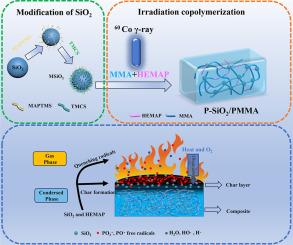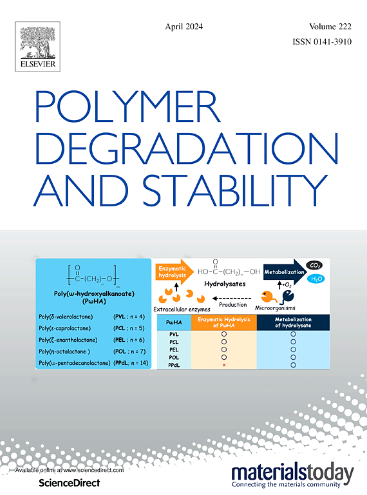Preparation of high transparency, thermal stability, flame retardant polymethyl methacrylate nanocomposite via gamma-radiation polymerization
IF 6.3
2区 化学
Q1 POLYMER SCIENCE
引用次数: 0
Abstract
Achieving flame retardancy and thermal stability in poly(methyl methacrylate) (PMMA) while maintaining its inherent high transparency presents a significant challenge. In this work, we successfully fabricated an exceptional composite (P-SiO2-PMMA) with high transparency, flame retardancy, and thermal stability using 60Co γ-ray irradiation-induced copolymerization of methyl methacrylate (MMA), 2-hydroxyethyl 2-methyl-2-propenoate phosphate (HEMAP), and nano-silica (SiO2). The impact of the HEMAP on the crystal, optical, thermal stability, and combustion behavior properties of P-SiO2-PMMA has been investigated. P-SiO2/PMMA forms a three-dimensional network cross-linked molecular chain structure, enhancing the thermal decomposition temperature (Tdi), maximum thermal decomposition temperature (Tmax), glass transition temperature (Tg), and reducing the coefficient of thermal expansion (CTE). HEMAP and SiO2 significantly enhance the flame retardancy of the material. The limiting oxygen index (LOI) value of transparent flame-retardant 20-P-SiO2/PMMA composite material increased from 17.5% for PMMA to 23.2%, with a 47.3% decrease in peak heat release rate (PHRR). The flame retardant mechanism was also investigated. This study offers a novel approach for the industrial application of high transparency, thermal stability, and halogen-free flame-retardant PMMA composite.

通过伽马辐射聚合制备高透明度、热稳定性和阻燃性聚甲基丙烯酸甲酯纳米复合材料
实现聚甲基丙烯酸甲酯(PMMA)的阻燃性和热稳定性,同时保持其固有的高透明度是一项重大挑战。在这项工作中,我们利用 60Co γ 射线辐照诱导甲基丙烯酸甲酯 (MMA)、2-羟乙基 2-甲基-2-丙烯酸酯磷酸酯 (HEMAP) 和纳米二氧化硅 (SiO2) 的共聚,成功制备了一种具有高透明度、阻燃性和热稳定性的特殊复合材料(P-SiO2-PMMA)。研究了 HEMAP 对 P-SiO2-PMMA 的晶体、光学、热稳定性和燃烧行为特性的影响。P-SiO2/PMMA 形成了三维网络交联分子链结构,提高了热分解温度 (Tdi)、最大热分解温度 (Tmax)、玻璃化转变温度 (Tg),并降低了热膨胀系数 (CTE)。HEMAP 和 SiO2 能显著提高材料的阻燃性。透明阻燃 20-P-SiO2/PMMA 复合材料的极限氧指数 (LOI) 值从 PMMA 的 17.5% 提高到 23.2%,峰值热释放率 (PHRR) 降低了 47.3%。此外,还研究了阻燃机理。这项研究为高透明度、热稳定性和无卤阻燃 PMMA 复合材料的工业应用提供了一种新方法。
本文章由计算机程序翻译,如有差异,请以英文原文为准。
求助全文
约1分钟内获得全文
求助全文
来源期刊

Polymer Degradation and Stability
化学-高分子科学
CiteScore
10.10
自引率
10.20%
发文量
325
审稿时长
23 days
期刊介绍:
Polymer Degradation and Stability deals with the degradation reactions and their control which are a major preoccupation of practitioners of the many and diverse aspects of modern polymer technology.
Deteriorative reactions occur during processing, when polymers are subjected to heat, oxygen and mechanical stress, and during the useful life of the materials when oxygen and sunlight are the most important degradative agencies. In more specialised applications, degradation may be induced by high energy radiation, ozone, atmospheric pollutants, mechanical stress, biological action, hydrolysis and many other influences. The mechanisms of these reactions and stabilisation processes must be understood if the technology and application of polymers are to continue to advance. The reporting of investigations of this kind is therefore a major function of this journal.
However there are also new developments in polymer technology in which degradation processes find positive applications. For example, photodegradable plastics are now available, the recycling of polymeric products will become increasingly important, degradation and combustion studies are involved in the definition of the fire hazards which are associated with polymeric materials and the microelectronics industry is vitally dependent upon polymer degradation in the manufacture of its circuitry. Polymer properties may also be improved by processes like curing and grafting, the chemistry of which can be closely related to that which causes physical deterioration in other circumstances.
 求助内容:
求助内容: 应助结果提醒方式:
应助结果提醒方式:


